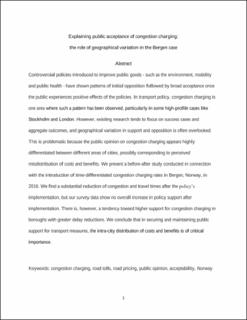| dc.contributor.author | Tvinnereim, Endre | |
| dc.contributor.author | Haarstad, Håvard | |
| dc.contributor.author | Rødeseike, Annika | |
| dc.contributor.author | Bugnion, Veronique | |
| dc.date.accessioned | 2021-06-28T12:05:46Z | |
| dc.date.available | 2021-06-28T12:05:46Z | |
| dc.date.created | 2021-01-31T17:23:22Z | |
| dc.date.issued | 2020 | |
| dc.identifier.issn | 2213-624X | |
| dc.identifier.uri | https://hdl.handle.net/11250/2761650 | |
| dc.description.abstract | Controversial policies introduced to improve public goods - such as the environment, mobility and public health - have shown patterns of initial opposition followed by broad acceptance once the public experiences positive effects of the policies. In transport policy, congestion charging is one area where such a pattern has been observed, particularly in some high-profile cases like Stockholm and London. However, existing research tends to focus on success cases and aggregate outcomes, and geographical variation in support and opposition is often overlooked. This is problematic because the public opinion on congestion charging appears highly differentiated between different areas of cities, possibly corresponding to perceived misdistribution of costs and benefits. We present a before-after study conducted in connection with the introduction of time-differentiated congestion charging rates in Bergen, Norway, in 2016. We find a substantial reduction of congestion and travel times after the policy’s implementation, but our survey data show no overall increase in policy support after implementation. There is, however, a tendency toward higher support for congestion charging in boroughs with greater delay reductions. We conclude that in securing and maintaining public support for transport measures, the intra-city distribution of costs and benefits is of critical importance. | en_US |
| dc.language.iso | eng | en_US |
| dc.publisher | Elsevier | en_US |
| dc.rights | Attribution-NonCommercial-NoDerivatives 4.0 Internasjonal | * |
| dc.rights.uri | http://creativecommons.org/licenses/by-nc-nd/4.0/deed.no | * |
| dc.title | Explaining public acceptance of congestion charging: The role of geographical variation in the Bergen case | en_US |
| dc.type | Journal article | en_US |
| dc.type | Peer reviewed | en_US |
| dc.description.version | acceptedVersion | en_US |
| dc.rights.holder | Copyright 2020 Elsevier | en_US |
| cristin.ispublished | true | |
| cristin.fulltext | postprint | |
| cristin.qualitycode | 1 | |
| dc.identifier.doi | 10.1016/j.cstp.2020.04.007 | |
| dc.identifier.cristin | 1883968 | |
| dc.source.journal | Case Studies on Transport Policy | en_US |
| dc.source.pagenumber | 992-1001 | en_US |
| dc.relation.project | Norges forskningsråd: 295014 | en_US |
| dc.identifier.citation | Case Studies on Transport Policy. 2020, 8(3), 992-1001 | en_US |
| dc.source.volume | 8 | en_US |
| dc.source.issue | 3 | en_US |

